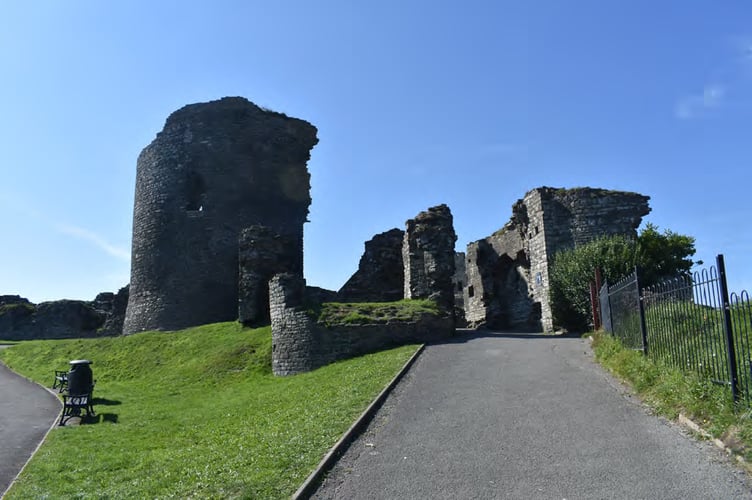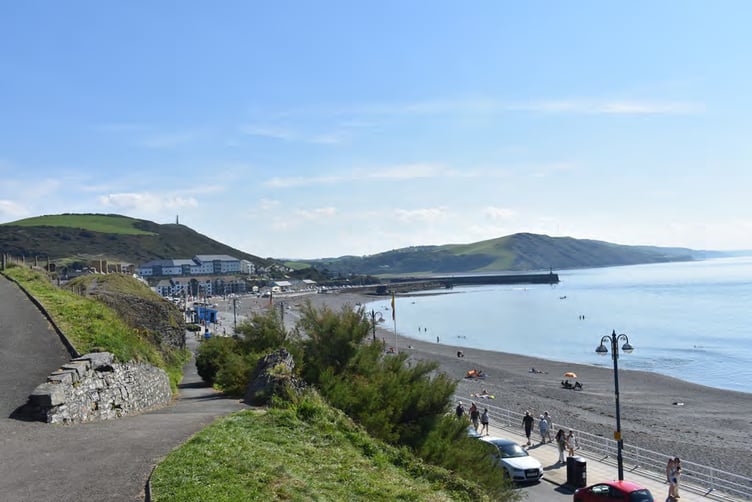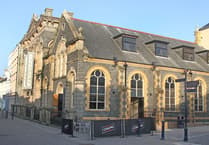While Aberystwyth appears to many to be a substantial Victorian seaside town, it actually started life as an important medieval settlement - and in a Ceredigion County Council led appraisal of the town’s conservation area, the history of the town is uncovered in detail to find out what makes Aberystwyth so special.
A potted history of the town, developed as part of plans to preserve its historic features through a conservation area appraisal and management plan, says that while Aberystwyth “today is dominated by its seafront location and the impressive sweep of the Victorian terraced development along the promenade”, the town’s medieval roots can still be seen to this day.
While evidence has been found that suggests some form of prehistoric settlement in the Tan-Y-Bwlch area, the Iron Age fort at Pen Dinas, to the south of the town, suggests that there was at least a later presence before 700BC.
The story of Aberystwyth, however begins by drawing on the success of the early Christian community at Llanbadarn Fawr.
Aberystwyth was part of the ancient parish of Llanbadarn Fawr with its important Medieval monastic settlement until 1861.
The settlement at Llanbadarn Fawr is known to have been in existence from the 10th century.
The settlement was known as Llanbadarn Gaerog (or fortified Llanbadarn) until about 1400, when the name Aberystwyth was first used.
An early 12th-century Norman castle was built by Gilbert Fitz Richard on the southwest bank of the Ystwyth overlooking its original mouth (Tan y Castell or Old Aberystwyth Castle).
A settlement beside this castle was mentioned in 1197, when it was attacked by Gwenwynwyn ab Owain Cyfeiliog, the last major ruler of mid Wales before the completion of the Norman English invasion.
Aberystwyth was one of the first Castle Towns to be established by Edward I with its charter being granted in 1277.
The Castle and a walled town were built by Edward’s brother Edmund of Lancaster with the town wall defences starting in 1278.

Much of the town was destroyed during a Welsh revolt in 1282 but the Castle and walls were substantially complete by 1289.
The Castle ruins are the only standing structures to survive from this early period, but the Medieval town street pattern is virtually intact together with the distinctive layout of the Medieval burgage plots.
The Medieval town was laid out in a typical grid pattern which still defines the grain of development in the area around the Castle.
The line of the walls and ditch is still followed by King Street, Baker Street, Chalybeate Street, Mill Street and South Road.
There was a gate at the foot of Great Darkgate Street, at the junction with North Parade where it is intersected by the line of Baker Street and Chalybeate Street, and another at the foot of Bridge Street adjacent to the bridge.
There was a third gate at the end of Eastgate.
Parts of the town walls survived until the early 19th century, when the gates were finally removed and the stone of the walls extensively appropriated for building work elsewhere.
The town was the victim of Welsh unrest during the late Medieval period.
It was burnt by Owain Glyndwr in 1401, taken by his forces in 1404 and retaken by the English in 1408 after Owain Glyndwr surrendered to the future King Henry V.
As such it failed to prosper during this time and by the 1530s, John Leyland found the walls in a ruinous state.
By the late 16th century, there were only ‘three or four core inhabited houses and as many if not more uninhabited dwellings in decay’ (W.J. Lewis (1959) ‘Some aspects of the history of Aberystwyth’, Ceredigion, Vol. III, No. 4).
During the Tudor period, once again Aberystwyth was the victim of internal unrest, particularly during the Civil War.
By 1636 the castle was largely ruinous and in 1637 a Royal Mint was established here which operated for just three years from 1639 to 1642.
The castle was held for the Royalists, taken by the Parliamentarian forces after a siege, and deliberately ruined in 1649.
Little development appears to have occurred during this period.
Two areas of common land on either side of Bridge Street and other open areas behind the properties on Pier Street, remained undeveloped until the end of the 18th century.
No building was permitted on the common land, which lay beyond the walls, until 1797.
The Georgian Period was one of agricultural revolution, industrialisation and economic prosperity for the UK.
The oldest surviving buildings in the town date from this period and it is clear that its fortunes were changing as it grew on the back of the local lead mining industry and became popular as a seaside resort.
During this period the custom house was transferred to Aberystwyth from Aberdyfi in 1763, a harbour trust was established in 1780, and the harbour was finally improved in the 1830s, starting with the construction of a stone pier (extended in 1858 and the 1870s).
Before 1808, the common was unenclosed land over which the burgesses enjoyed special rights. Between 1813 and 1834 the Court Leet let much of the old common on long leases to pay legal fees and this allowed the town to expand greatly.
Having had control over the town, its markets, development, law and order and so on since the late 1600s, the Court Leet ceased to exist at the end of 1835 with the passing of the Municipal Corporations Act.
The Powells of Nanteos were large land holders and built several significant developments within the town.
Notably, the residential development at Laura Place, the Assembly Rooms in 1820 and buildings in Pier Street, Eastgate, New Street and Market Street.
Other influential wealthy families, such as the Pryse family of Gogerddan, also built prominent residences and other buildings within the town as it became fashionable with the elite.
New hotels and inns were built to accommodate the new tourism industry as well as purpose built letting houses.
Marine baths were established by 1809, the Promenade started by 1819 and by 1848, 60 houses had been built along Marine Terrace.
In 1835 two Acts of Parliament changed the way in which the development of the town was controlled.
The Municipal Corporations Act abolished the Court Leet and introduced the elected Borough Council and a local Improvement Act which set up Town Improvement Commissioners to improve the town and supply it with water.
During the Victorian Period, the Commissioners and the Borough Council undertook or oversaw a number of improvement works within the town which enhanced conditions within the town and contributed to its development.

These included setting up the town’s own water supply, construction of drains and sewers, street lighting with gas and later the provision of electricity and the replacement of the cobbled pavements with flagstones.
Around this time also saw the setting up the Aberystwyth Police Force, the construction of a new County Hall, a new market in St. James's Square, and a fish market below the Guild Hall.
There was also the election of a School Board and opening of a Board School (now Ysgol Gymraeg) in Alexandra Road, and the opening of a free public library in 1874.
The Cattle market was moved from the Queen's Road area to Park Avenue, Hotel Cambria was built along with a new hospital at North Road.
The construction of the Cliff Railway was completed, while a now demolished town clock was also built.
The-then Borough Council also undertook slum clearances in Skinner Street, Poplar Row and Trinity Row in the early 20th century.
The authorities continued to grant leases for new private building works, although with strict design and scale restrictions controlled by the leases.
It was during this period that the town further expanded in response to additional tourism demand, partially due to new access via the railways (Aberystwyth and Welsh Coast Railway in 1864, and the Manchester and Milford Railway (from Carmarthen) in 1867).
The railway's arrival gave rise to a tourist boom, with Aberystwyth becoming a significant holiday destination, even being dubbed the ‘Biarritz of Wales.’
Construction on former areas of common land allowed larger structures than developing solely within the grid of Medieval streets.
New styles development, the railway brought in new materials and extravagant architecture was planned if not always executed.
More boarding houses were built on Marine Terrace, while the enormous Queen's Hotel was completed in 1866.
Another large hotel was begun near the Castle, around the old Castle House, subsequently bought by the University College of Wales when funds ran out
Construction of a sea wall in front of the Queens Hotel - later extended to the foot of Constitution Hill – was completed, along with the building of Victoria Terrace.
Back lanes and some of the old burgages such as Crynfryn Row were also built up, with New Street and Market Street both created and laid out in the 1830s.
The time saw the development of artisan housing along new streets such as Powell Street, William Street, George Street and existing streets such as High Street and Custom House Street, and the development of the suburbs at The Buarth, Llanbadarn Road and North Road.
A bathhouse was constructed on rocks near the Queen's Hotel, while construction was completed on the Vale of Rheidol Railway.
The rebuilding of Aberystwyth promenade and seafront properties following a storm in 1938 led to the construction of defences which were completed two years later.
There has been little impactful development within the conservation area during the 20th and 21st centuries, since most major development during these periods took place at the edges of the town including the construction of the National Library buildings, the new University buildings and extensive suburbs.
There has, however, been some replacement of commercial buildings within the town centre, mostly during the mid to late 20th century and limited modern hotel or flats development.
Some of the commercial developments from the 1960s and 1970s would now be considered to be intrusive.
During the 1930s construction of entertainment venues such as the King's Hall (now replaced by modern flats), bandstand, putting green, tennis courts and a swimming pool at Plascrug were typical but also limited.
During the modern period there has been piecemeal replacement and alteration of pavements and roads, provision and replacement of street furniture and signage, some replacement of traditional shopfronts and signage, accessibility improvements, and construction of out of town shopping centres and car parks.
Aberystwyth’s conservation area was designated in 1969 and extended in 1980, 1981 and 1984. It covers the core of the town along the shoreline and north of the railway line.
The conservation area appraisal report, in its summary, says: “Whilst Aberystwyth appears to many to be a substantial Victorian seaside town, it started as an important Medieval settlement, no doubt drawing on the success of the early Christian community at Llanbadarn Fawr, whilst taking advantage of Aberystwyth's natural topography and location.
“In fact, Aberystwyth has many high quality and important Georgian buildings in addition to its renowned Victorian architecture and the Medieval street layout defines much of the current town.
“Nevertheless, Aberystwyth today is dominated by its seafront location and the impressive sweep of the Victorian terraced development along the Promenade.
“A wide diversity of Victorian styles of architecture demonstrate its phases of development during this period, combining commercial, civic, spiritual, domestic and recreational buildings into streetscapes which showcase a delightful variety of design and materials, punctuated by pleasant and active open spaces.
“Careful and high quality architectural detailing is a hallmark of Georgian and Victorian architecture and Aberystwyth is no exception, hosting myriad examples of ironwork, decorative stone, brick and tile, windows, doors, porches, and many other examples.”
The report says that Aberystwyth’s “special location, next to the sea with a natural harbour and stunning coastline and surrounded by protective hills and picturesque landscape, was undoubtedly part of the reason for the choice of location for earlier settlement and has contributed to the town’s success and development over time.”





Comments
This article has no comments yet. Be the first to leave a comment.